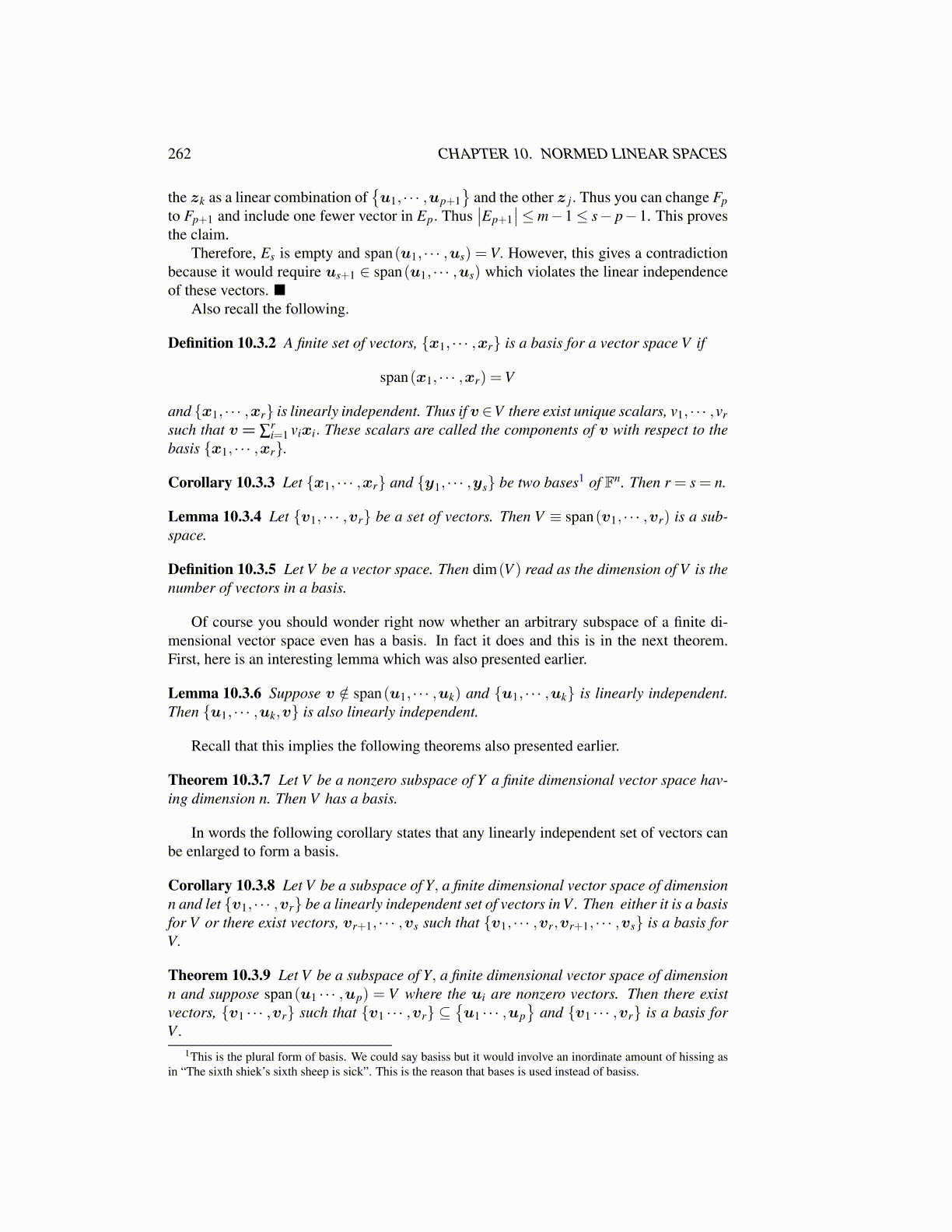
262 CHAPTER 10. NORMED LINEAR SPACES
the zk as a linear combination of{u1, · · · ,up+1
}and the other z j. Thus you can change Fp
to Fp+1 and include one fewer vector in Ep. Thus∣∣Ep+1
∣∣≤ m−1≤ s− p−1. This provesthe claim.
Therefore, Es is empty and span(u1, · · · ,us) = V. However, this gives a contradictionbecause it would require us+1 ∈ span(u1, · · · ,us) which violates the linear independenceof these vectors. ■
Also recall the following.
Definition 10.3.2 A finite set of vectors, {x1, · · · ,xr} is a basis for a vector space V if
span(x1, · · · ,xr) =V
and {x1, · · · ,xr} is linearly independent. Thus if v ∈V there exist unique scalars, v1, · · · ,vrsuch that v = ∑
ri=1 vixi. These scalars are called the components of v with respect to the
basis {x1, · · · ,xr}.
Corollary 10.3.3 Let {x1, · · · ,xr} and {y1, · · · ,ys} be two bases1 of Fn. Then r = s = n.
Lemma 10.3.4 Let {v1, · · · ,vr} be a set of vectors. Then V ≡ span(v1, · · · ,vr) is a sub-space.
Definition 10.3.5 Let V be a vector space. Then dim(V ) read as the dimension of V is thenumber of vectors in a basis.
Of course you should wonder right now whether an arbitrary subspace of a finite di-mensional vector space even has a basis. In fact it does and this is in the next theorem.First, here is an interesting lemma which was also presented earlier.
Lemma 10.3.6 Suppose v /∈ span(u1, · · · ,uk) and {u1, · · · ,uk} is linearly independent.Then {u1, · · · ,uk,v} is also linearly independent.
Recall that this implies the following theorems also presented earlier.
Theorem 10.3.7 Let V be a nonzero subspace of Y a finite dimensional vector space hav-ing dimension n. Then V has a basis.
In words the following corollary states that any linearly independent set of vectors canbe enlarged to form a basis.
Corollary 10.3.8 Let V be a subspace of Y, a finite dimensional vector space of dimensionn and let {v1, · · · ,vr} be a linearly independent set of vectors in V . Then either it is a basisfor V or there exist vectors, vr+1, · · · ,vs such that {v1, · · · ,vr,vr+1, · · · ,vs} is a basis forV.
Theorem 10.3.9 Let V be a subspace of Y, a finite dimensional vector space of dimensionn and suppose span(u1 · · · ,up) = V where the ui are nonzero vectors. Then there existvectors, {v1 · · · ,vr} such that {v1 · · · ,vr} ⊆
{u1 · · · ,up
}and {v1 · · · ,vr} is a basis for
V .1This is the plural form of basis. We could say basiss but it would involve an inordinate amount of hissing as
in “The sixth shiek’s sixth sheep is sick”. This is the reason that bases is used instead of basiss.